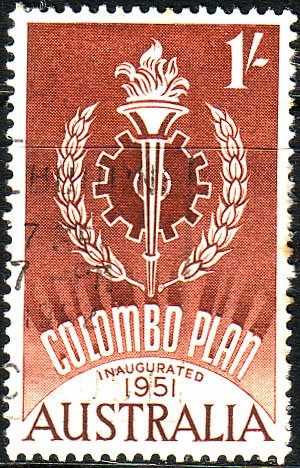On this day, 9 January 1950, Commonwealth Foreign Ministers meet in Ceylon (now Sri Lanka) for talks that will produce what will become known as the ‘Colombo Plan’ of foreign aid investment. The plan would prove to be a tremendous success, fostering development in the Asia-Pacific region, improving the lives of millions, and continuing to operate until the present day. Australia’s central role in pushing for the plan was a huge step forward in our engagement with our ‘near north’, and the implementation of educational programs associated with the plan would help to break down the infamous ‘White Australia Policy’.
The Colombo summit was the first Commonwealth Ministers’ Meeting to be held on Asian soil, and it was the first held with representation from the newly independent nations of India, Pakistan and Ceylon. However, its focus was somewhat shifted by the Proclamation of the People’s Republic of China on 1 October 1949 and the beginning of a long-term communist insurgency in Malaya. In these circumstances Australia’s goals for the meeting crystalised: it had to come to terms with decolonisation in the region and forge relationships with the new republics, but above all it wanted to ensure that the spread of communism in the region was contained.
The Menzies Government had only recently come to power, and the newly-minted Foreign Minister Percy Spender allegedly came up with the idea for the plan en route to the meeting. He later explained that he was seeking a way to support Asian nations in their bid to ‘develop their own democratic institutions and their own economies and thus protect them against those opportunists and subversive elements which take advantage of changing political situations and low living standards’. Communist leaders preyed upon the poverty of their potential supporters, so if the region was to be protected against this threat the key was to foster prosperity – and the Menzies Government believed that the Commonwealth and direct bi-lateral programs, rather than the UN, would be best placed to achieve this.
Spender played a central role in the adoption of a plan which called for ‘the Commonwealth to contribute to the UN’s Technical Assistance Program, to provide aid to Asia on a bilateral basis, to coordinate the aid delivery with other Commonwealth governments, and for Asian nations to make submissions detailing their development needs, and for the conference to establish a consultative committee to oversee the logistics of delivering aid to the region’. The Consultative Committee would be at the heart of the enterprise, as its meetings would foster what were essentially targeted bi-lateral agreements for technical assistance and aid. Initially the recipients would just be the conference attendees India, Pakistan and Ceylon, but the goal was to expand to other countries in the region as soon as possible.
Though the Commonwealth was to be the initial vehicle, it was clear that Britain’s role would be limited. The heart of the old Empire was economically exhausted, mistrusted because of its colonialist past, and its interests were shrinking. Instead, Australia would lay much of the groundwork for the plan and successfully seek the backing of the new global power the United States – having to drop the label ‘Commonwealth’ from the Consultative Committee as a condition. Soon Indo-China, Malaya, Burma, Indonesia, Thailand, and the Philippines had signed on, while Japan became the first Asian nation to join as an aid-donor.
Australian foreign aid spending grew significantly under Menzies, reaching historic highs under the Coalition governments that proceeded his retirement, and this was due in large part to commitments entered into under the plan. Australian spending on Colombo was tallied at $160 million from its inception until June of 1968. A key aspect of the assistance was to provide education for Asian students – potential leaders, engineers, doctors etc. By the time Menzies left office more than 5,000 students had received these grants to attend university in Australia, and by 1985 that number had reached 20,000. The influx of multi-racial students onto campus helped to breakdown colour barriers, and teach a whole generation of Australian students that their regional counterparts were just as intelligent and hardworking as they were.
In 1955 Menzies contended that Australia had made ‘substantial contributions to the store of capital and other goods and of goodwill in several Asian countries’ and that ‘personal contacts between Asian students and the Australian people in Australia and between Australian experts and the countries they have visited, and the physical symbols of goodwill to be found in Colombo Plan programs, have all helped to make our attitude and the integrity of our motives better understood and reciprocated’.
In the end the nations of Asia did not fall like ‘dominos’ to communism in the manner that in 1950 it appeared they might, and while the Colombo Plan may have played a significant role in this eventuation such causation can only ever be hypothetical. In more tangible terms, Colombo greatly increased Australia’s standing in the region. We demonstrated that we were willing to help our neighbours and we got to know them in the process. Both sides were enriched by the experience.
Further Reading:
Daniel Oakman, Facing Asia: A History of the Columbo Plan (ANU E Press, 2010).
Robin Davies, ‘Measuring Australia’s foreign aid generosity, from Menzies to Turnbull’, Defensive Policy Centre, Policy Brief 16, February 2017.
Sign up to our newsletter
Sign up for our monthly newsletter to hear the latest news and receive information about upcoming events.


